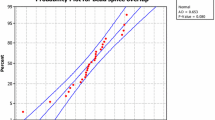Abstract
The concept of robust engineering (RE) which is based on the philosophy of Genichi Taguchi aims at providing industries with a cost effective methodology for enhancing their comptetive position in the global market. Since in most cases it is not possible to model the mathematical relationship between quality characteristic (QC), parameter designs and noise factors of situation under study, a proper statistical model in design of experiments (DOE) is proposed. However, the used statistical procedures in DOE are based on normality assumption of real data of QC or its transformed distribution. In many engineering cases, the data is highly skewed and therefore cannot be always removed by usual transformations; and even if it will be removed to a great extend, it may lead to inaccurate inferences in model parameters. Alternatively, the Inverse Gaussian family of distributions is flexible enough to provide a suitable model for these types of data. In this study, in dealing with such type of data, the concept of RE method is combined with Inverse-Gaussian (IG) model to reduce total deviations from target values of 17 quality characteristics in oil pump housings produced by Iranian diesel engine manufacturing (IDEM) company. As the distridution of data obtained from RE methodology follows the IG, the analysis without any data transformation (uncontrary in traditional RE procedure) is done straight forward through an IG model, and then its analysis is compared with customary analysis of RE method. This paper consists of four sections. The first section provides a brief description of problem. Section two gives a brief introduction to RE methodology. Section three devoted to introducing the proposed DOE model which is base upon inverse-Gaussian distribution. In section four, application of the two approaches to improve quality of produced oil pump housings in IDEM are considered and their relative results are obtained. And finally, in section five, the analysis results of application of the two models are compared.
Similar content being viewed by others
References
R. J. Achcar O. L. A. Rosales (1992) ArticleTitleA Bayesian approach for accelerated life test assuuming an Inverse Gaussian distribution Estadistica 2 25–32
InstitutionalAuthorNameAmerican Supplier Institute Inc. (1989) Taguchi Methods: Implementation Manual ASI Dearborn, MI
Bameni M. M. (2004). Application of Robust Engineering Method in Oil Pump Housing Production Process. International Journal of Engineering Science 15(2).
A. K. Banerjee G. K. Bhattacharyya (1979) ArticleTitleBayesian results for the Inverse Gaussian distribution with an application Technometrices 21 247–251
A. Bendel (1988) Introduction to Taguchi Methodology. Taguchi Methods: Proceedings of the 1988 European Conference Elsevier Applied Science London 1–14
S. Bisgaard B. Ankenman (1996) ArticleTitleAnalytic Parameter Design Quality Engineering 8 IssueID1 75–91
G. K. Bhattacharyya A. Fries (1983) ArticleTitleAnalysis of two-factor experiments under an Inverse Gaussian model Journal of American Statistical Association 78 820–826
R. S. Chhicara L. Folks (1989) Inverse Gaussian distribution, Theory and applications Marcel Dekker New York
J. L. Folks R. S. Chhicara (1978) ArticleTitleThe Inverse Gaussian distribution and its statistical application – a review Journal of the Royal Statistic Society of Britain 40 263–275
A. Fries G. K. Bhattacharyya (1983) ArticleTitleAnalysis of two-factor experiments under an Inverse Gaussian model Journal of American Statistical Association 78 820–826
R. Kackar (1985) ArticleTitleOff-line Quality Control, Parameter Design, and the Taguchi Method Journal of Quality Technology 17 IssueID4 176–188
Meshkani, M. R. (2004). One-way and two-way analysis of variance for Inverse Gaussian distribution by empirical Bayes procedure. Journal of Science, to be appeared.
S. M. Phadke (1989) Quality Engineering Using Robust Design Prentice Hall Englewood Cliffs, NJ
K. Roy Ranjit (2001) Design of Experiments Using the Taguchi Approach John Wiley & Sons NY
J. J. Shuster C. Muira (1972) ArticleTitleTwo-way analysis of reciprocals Biometrika 59 478–481
G. Taguchi (1986) Introduction to Quality Engineering Asian Productivity Organization, American Supplier Institute Inc. Dearborn, MI
Taguchi, G. (1987). System of Experimental Designs. In: Don Clausing (ed.), Vol. 1 and 2 New York: UNIPUB/Kraus International Publications.
G. Taguchi S. Konishi (1987) Orthogonal Arrays and Linear Graphs American Supplier Institute Inc. Dearborn, MI
G. Taguchi R. Jugulum (2002) The Mahalanobis-Taguchi Strategy: A Pattern Technology System Wiley New York
M. C. K. Tweedie (1957) ArticleTitleStatistical Properties of Inverse Gaussian distributions Annals Mathematical Statistics 28 362–377
Unal, R. & Dean, E. B. (1999). Taguchi Approach to Design Optimization for Quality and Cost. Paper presented at the Annual Conference of the International Society of Parametric Analysis.
Author information
Authors and Affiliations
Corresponding author
Rights and permissions
About this article
Cite this article
Moghadam, M.B., Eskandari, F. Quality Improvement by Using Inverse Gaussian Model in Robust Engineering. Qual Quant 40, 157–174 (2006). https://doi.org/10.1007/s11135-005-8082-7
Issue Date:
DOI: https://doi.org/10.1007/s11135-005-8082-7




